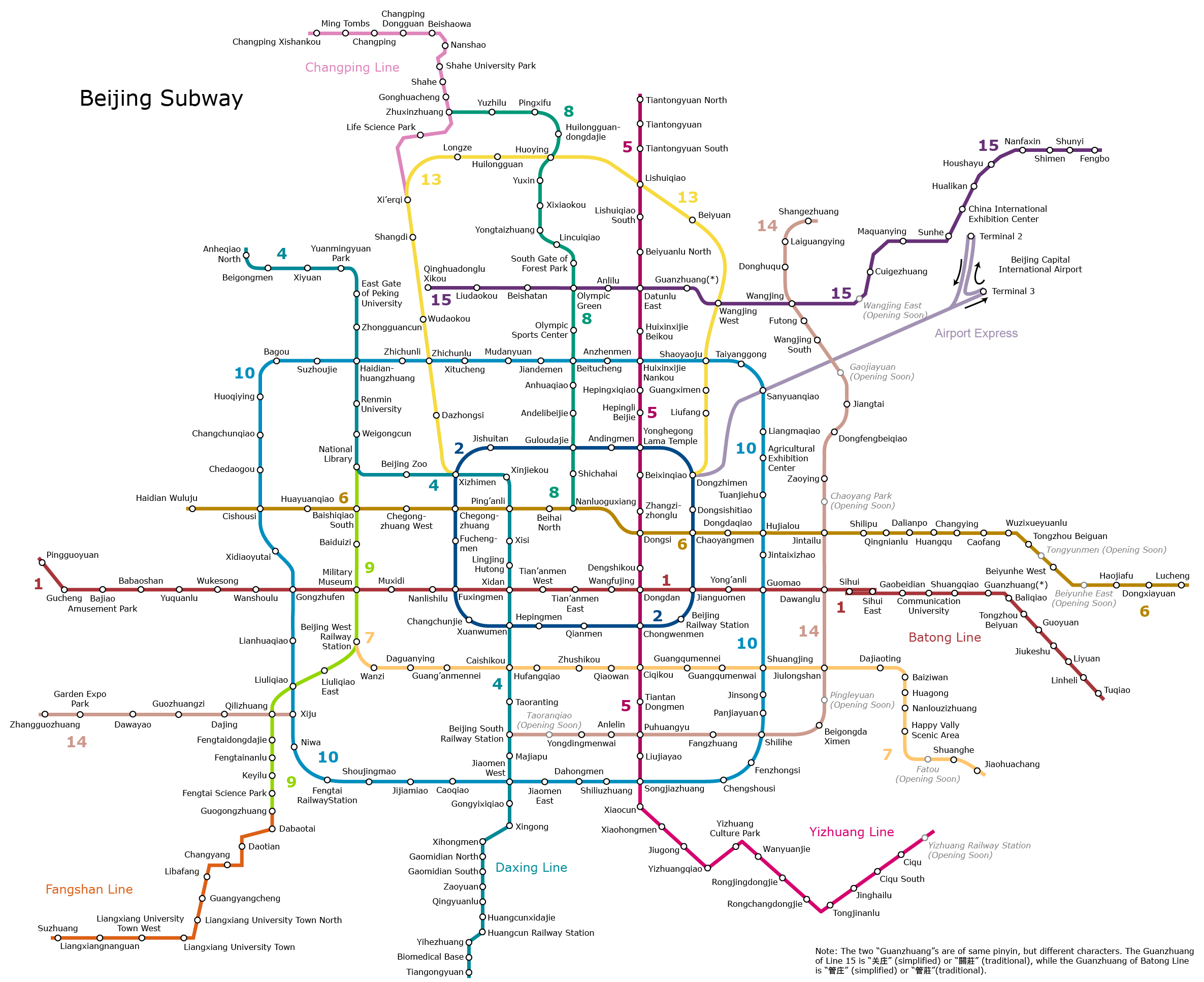Beijing Subway Information
The Beijing Metro is the oldest metro system in mainland China, having been in operation since 1 October 1969. After the Shanghai Metro, it is the second longest metro network with 18 lines, 334 stations and a length of 554 km. However, it is no longer able to meet the needs of the Chinese population and expansion plans are already underway. By 2020, the network is expected to be around 1050 km long. What’s surprising is that it is still the world’s busiest metro system in terms of annual ridership, which is a staggering 3.25 billion (2015). Of the 18 lines, 15 are operated and owned by the Beijing Mass Transit Railway Operation Corp. The remaining 3 lines are operated by Beijing MTR Corp.
Beijing Subway Map
Map of Beijing Subway showing different lines and stations. Click on the map to enlarge it.
Beijing Subway Line
Beijing Subway operates through 18 lines serving 315 stations total. All the metro lines are recognized by its color.
- Line1 – line 1 was opened in 1969 serving 23 stations. Line 1 operates between Pingguoyuan and Sihui East.
- Line 2 – line 2 was opened in 1971 serving 18 stations. The line runs between Xizhimen and Beijing railway station.
- Line 4 – Line 4 was opened in 2009 serving 24 stations. The metro line operates between Anheqiao North and Gongyixiqiao.
- Line 5 – Line 5 was opened in 2007 serving 23 stations. The metro line operates between Tiantongyuan North and Songjiazhuang.
- Line 6 – Line 6 was opened in 2012, serving 26 stations. The metro line operates between Haidian Wuluju and Lucheng.
- Line 7 – Line 7 was opened in 2014, serving 19. The metro line operates between Beijing West Railway Station and Jiaohuachang.
- Line 8 – Line 8 was opened in 2008, serving 17 stations. The metro line operates between Zhuxinzhuang and Nanluoguxiang.
- Line 9 – Line 9 was opened in 2012, serving 13 stations. The metro line operates between National Library and Guogongzhuang.
- Line 10 – Line 10 was opened in 2008 serving 45 stations. Line 10 operates between Xiju and Shoujingmao.
- Line 13– line 13 was opened in 2002 serving 16 stations. Line 13 operates between Xizhimen and Dongzhimen.
- Line 14 (west)- Line 14(west) was opened in 2013, serving 7 stations. The metro line operates between Zhangguozhuang and Xiju.
- Line 14 (east)- Line 14 (east) was opened in 2014, serving 19 stations. The metro line operates between Beijing South Railway Station and Shan’gezhuang.
- Line 15 – Line 15 was opened in 2010, serving 18 stations. The metro line operates between Qinghuadongluxikou and Fengbo.
- Batong Line – Batong line was opened in 2003 serving 13 stations. The line operates between Sihui and Tuqiao.
- Changping Line – The line was opened in 2010, serving 12 stations. The metro line operates between Changping Xishankou and Xi’erqi.
- Daxing Line – the line was opened in 2010 serving 12 stations. The line serves between Gongyixiqiao and Tiangongyuan.
- Fangshan Line – The line was opened in 2010 serving 11 stations. The line serves between Guogongzhuang and Suzhuang.
- Yizhuang Line – The line was opened in 2010 serving 13 stations. The line serves between Songjiazhuang and Ciqu.
- Airport Express – the line was opened in 2008 serving 4 stations. The line operates between Dongzhimen and terminal 2 &3.
Beijing Subway Hours
The metro starts at 5.00 am on all lines. The last train leaves the last station at 23:00 and the metro closes after midnight. Airport Express services start at 6am.
Beijing Subway Fares
As of 28 December 2014, Beijing Subway has ended the flat fare system and introduced a distance-based fare on all lines except the Airport Express. The minimum fare on Beijing Subway is now 3 yuan, which covers the first 6 km, and the fare increases based on the length of the distance to be travelled. If Airport Express passengers need to travel on other subway lines, they have to pay the standard fares. Initially, fares were charged according to the number of transfers and line, and ranged from CNY3 to CNY10. All subway lines have automatic fare collection systems. Passengers can also use the One Card Through Card or Yikatong, which stores credit and can be used for multiple journeys. This card can also be used on all buses. Children under 1.2m tall can travel for free.
| Distance-based fare schedule | Discounts for Yikatong card users | ||
|---|---|---|---|
| Fare | Trip distance | Monthly Expenditure | Net Expenditure after credit rebate |
| ¥3 | <6 km | ¥50 | ¥50 |
| ¥4 | 6-12 km | ¥100 | ¥100 |
| ¥5 | 12-22 km | ¥150 | ¥140 |
| ¥6 | 22-32 km | ¥200 | ¥165 |
| ¥7 | 32-52 km | ¥300 | ¥215 |
| ¥8 | 52-72 km | ¥400 | ¥265 |
| ¥9 | 72-92 km | ¥500 | ¥365 |
| ¥10 | 92-112 km | ¥600 | ¥465 |
Beijing Subway Parking
Some metro stations offer park and ride facilities for passengers.
Beijing Subway Rules and Tips
To ensure the safety of passengers, metro stations are equipped with X-ray machines and sniffer dogs, and security staff also have metal detectors. Generally, only bags are X-rayed and passengers are occasionally searched. The carrying of flammable materials, weapons, knives and explosives is prohibited. Stations also have lifts, elevators and ramps to provide easy access for wheelchair users. All lines also have automatic announcements of incoming trains and station names are announced in English, Chinese and Mandarin. All lines, except the tunnels between stations on lines 1 and 2, have mobile phone coverage.






